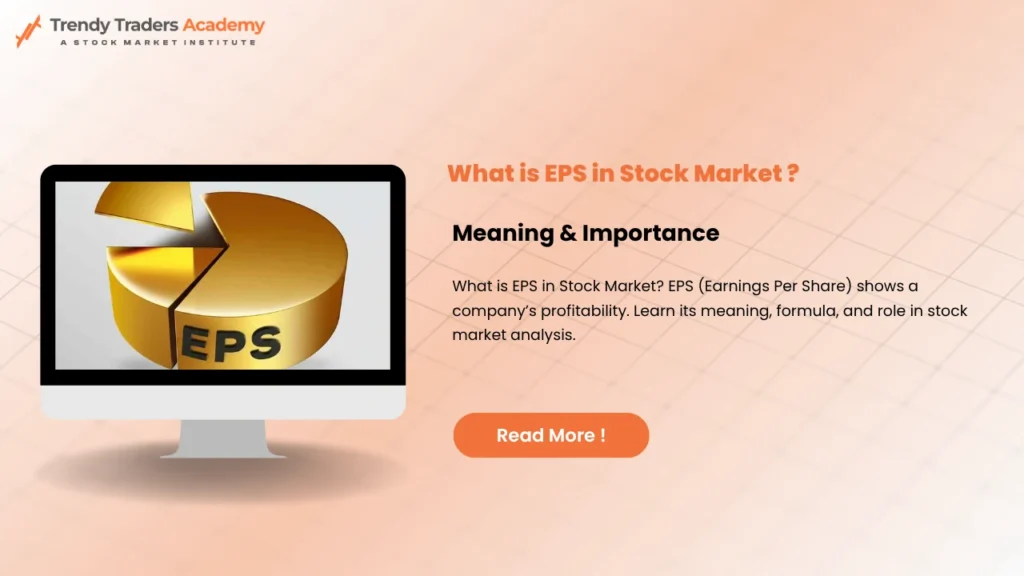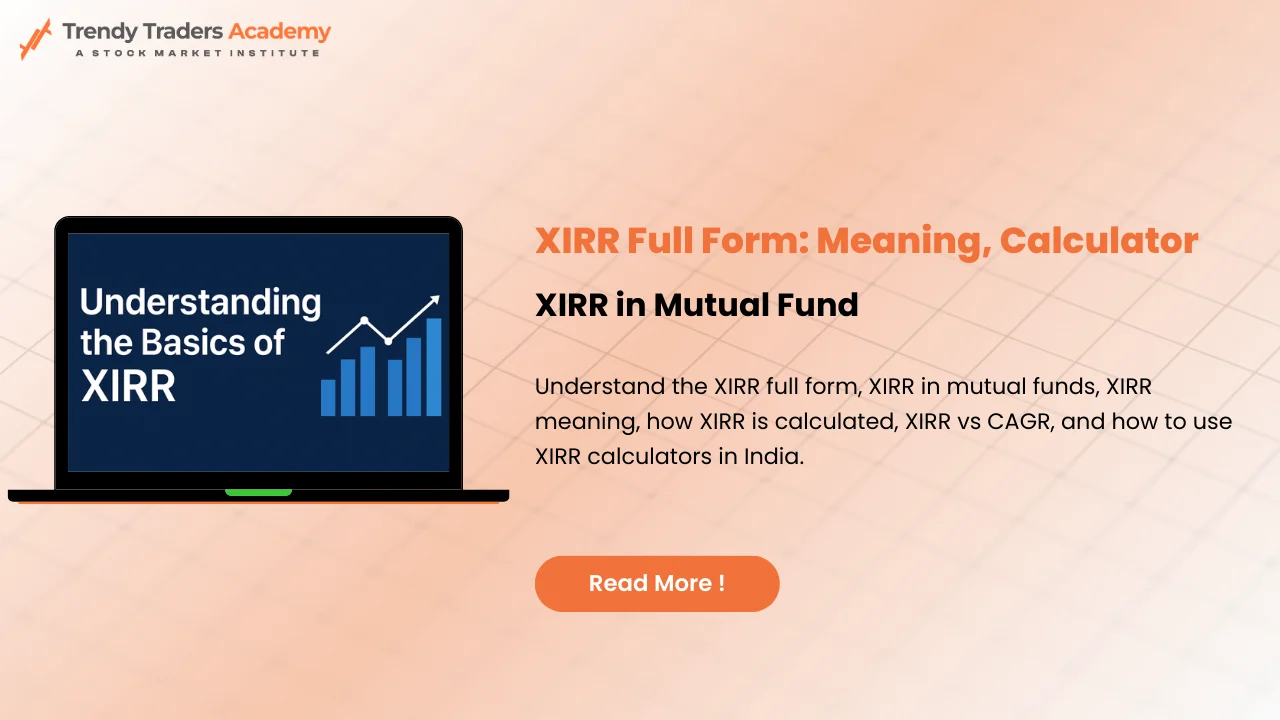
What is EPS in Stock Market? A Friendly Guide to Earnings Per Share
The Power of EPS in Your Investment Decisions
Imagine buying a slice of a pizza with friends. After the meal, someone asks: “How much pizza did I actually get?” In the world of stocks, this question transforms into “How much profit do I get per share?” The answer is hidden in a powerful acronym: EPS.
If you’re a beginner wondering what is EPS in stock market, or a curious investor comparing company results, this blog is for you. By the end, you’ll not only be able to explain EPS in stock market to anyone but also use “EPS full form in share market” effectively in your investment journey.
What Is EPS in Stock Market? The Simple Breakdown
EPS, or Earnings Per Share, is a key number that shows how much profit a listed company makes for each individual share. To put it in everyday terms, think of a company’s total yearly profit as a big cake—EPS tells you how big a slice each shareholder actually gets.
EPS full form in share market:
E – Earnings
P – Per
S – Share
So, EPS in stock market literally means a company’s “earnings for every single share available.”
EPS Explained with an Analogy
Scenario | What’s Happening | EPS Comparison |
A pizza split among 10 kids | If pizza is profit and kids are shares | Slice = how much each gets (EPS) |
Profits of a company | If profit is cake and shares are people | Cake slice = EPS per shareholder |
Farmer splitting apples | 100 apples (profit), split among 20 bags | 5 apples per bag = 5 EPS |
Why is EPS in Stock Market So Important?
- Quick Profit Check: EPS tells you how much profit is available to you, the shareholder, not just the company.
- Comparison Tool: It’s easier to compare two companies using EPS than by simply looking at their net profits.
- Investor Magnet: High and sustainable EPS figures are often magnets for investors seeking value and stability.
EPS in stock market simply translates “how much am I earning from every share I own?”
How to Calculate EPS in Stock Market
Calculating EPS in stock market doesn’t require a finance degree. Here’s the basic formula:
EPS Formula
EPS=Net Profit−Preferred DividendsTotal Number of Outstanding Shares
EPS=
Total Number of Outstanding Shares
Net Profit−Preferred Dividends
- Net Profit: Total profit after tax in a year.
- Preferred Dividends: Profits paid to preference shareholders first.
- Outstanding Shares: Total shares that exist in the market.
Example Table: Calculating EPS Step-by-Step
Company | Net Profit (₹) | Preferred Dividends (₹) | Outstanding Shares | EPS (₹) |
Alpha Ltd | 10,00,000 | 1,00,000 | 2,00,000 | (10,00,000-1,00,000)/2,00,000 = ₹4.5 |
Beta Ltd | 5,00,000 | 50,000 | 50,000 | (5,00,000-50,000)/50,000 = ₹9 |
This example shows how two companies with very different profits can have vastly different EPS, based on how many shares are in circulation.
Types of EPS in Stock Market
EPS isn’t always “one-size-fits-all.” Here are common types you’ll spot in investment articles and company reports:
- Basic EPS: The simplest form, calculated using only existing shares.
- Diluted EPS: Adjusts for all convertible securities (like options or convertible bonds)—reflecting the worst-case scenario if all were turned into shares.
- Trailing EPS: Looks at the last four quarters.
- Forward (Estimated) EPS: Based on analysts’ expectations for future profits.
Types of EPS Side-by-Side
EPS Type | What It Reflects | When to Use |
Basic | Current situation (existing shares) | Quick, “what is now” view |
Diluted | If all convertibles were turned into shares | For conservative estimates |
Trailing | Last 12 months’ earnings | For past performance |
Forward | Projected future earnings | For growth projections |
Why Investors Rely On EPS in Stock Market
- Simplifies Valuation: A stock price divided by EPS gives the P/E ratio (Price/Earnings)—a gold standard for understanding if a stock is expensive or cheap.
- Tracks Growth: Rising EPS over time signals business is growing; falling EPS might ring alarm bells.
- Better Than Just Revenue: Big revenue means little if profits (and therefore EPS) are low or falling.
Real World Example: EPS Driving Investment Choices
Suppose you spot two companies:
- Company X: EPS is ₹10, share price is ₹120
- Company Y: EPS is ₹6, share price is ₹100
To see value, you divide price by EPS (P/E Ratio). If the industry average is a P/E of 20, Company X is trading at 12×, while Company Y is at almost 17×. Even though X’s shares look more expensive, they offer more profit per share, highlighting why investors check eps in stock market before investing.
EPS in Stock Market: When Good Isn’t Always Great
Investors love to see high EPS, but it’s not a stand-alone magic metric! Here’s why caution is needed:
- Different Sectors: Tech companies may naturally have lower EPS yet grow much faster than utility companies with steady, higher EPS.
- One-Time Profits: Sometimes, a sudden asset sale or windfall can spike EPS—always check if it’s recurring earnings.
- Share Buybacks: Companies can “artificially” boost EPS by reducing the number of shares via buybacks.
- Inflation & Dilution: If new shares are issued, EPS can drop even if the total profit rises.
EPS in Stock Market and the P/E Ratio
Investors rarely look at EPS alone. It’s almost always paired with the P/E (Price to Earnings) ratio.
P/E Ratio=Share PriceEPS
P/E Ratio=
EPS
Share Price
- High P/E: Stock may be overpriced or expected to grow rapidly
- Low P/E: Stock may be undervalued or could signal trouble
EPS and P/E in Context
Stock | EPS (₹) | Share Price (₹) | P/E Ratio | Likely Interpretation |
GHI Ltd | 8 | 64 | 8 | May be undervalued |
JKL Ltd | 2 | 50 | 25 | May be overvalued/growth priced in |
MNO Ltd | 10 | 100 | 10 | Reasonably valued |
Things to Remember About EPS in Stock Market
- EPS means “Earnings Per Share”—profit the company earns for one share in your portfolio.
- It’s a fast way to compare profitability across companies and industries.
- Always understand what’s behind EPS, especially extraordinary profits or sudden dips.
- Use EPS full form in share market context to impress at your next investor meet!
- Watch for changes to EPS due to buybacks or new share issues.
Storytelling Example: The Tale of Two Investors
Riya and Arjun are both exploring the stock market. Riya looks only at share prices. Arjun, however, wonders about “what is eps in stock market” and calculates EPS for each company he’s interested in.
After a year, Riya finds her stocks grew little, despite rising revenue everywhere. Arjun, who picked a mix of high, stable EPS stocks within fair P/E ratios, saw his portfolio outpace Riya’s—demonstrating that profit per share is crucial, not just the buzz around a company!
Conclusion: EPS in Stock Market—The Slice That Matters Most
If you’re serious about understanding stocks, mastering what is EPS in stock market is essential. Use it as your guiding metric—it’s your “profit per share” compass. Pair your analysis with other metrics, and you’ll avoid the common rookie mistake of chasing buzz over value.
An informed investor checks for solid, sustainable EPS before investing. Whether you call it eps in stock market, eps full form in share market, or simply “earnings per share,” let it drive your smartest investment decisions going forward.
FAQ'S
Is EPS always published quarterly?
Public companies announce EPS every quarter and at year-end—check financial statements or market sites.
Can EPS be negative?
Yes. If a company incurs losses, EPS will show as negative—that’s a red flag for investors.
Will EPS alone decide if a stock is good?
No, but it’s a vital first filter. Combine it with return on equity, P/E and other ratios.
What’s a ‘good’ EPS for a company?
There’s no magic number. Compare it to peers, watch for steady growth, and see if it matches industry standards.
EPS full form in share market
Earnings Per Share
What does EPS mean?
Profit left for each existing share of stock
How is EPS calculated?
Net profit (minus preferred dividends) divided by outstanding shares
Why compare EPS across companies?
To see which business is earning more per share
Does high EPS always mean a better company?
No—context, industry, and consistency all matter










